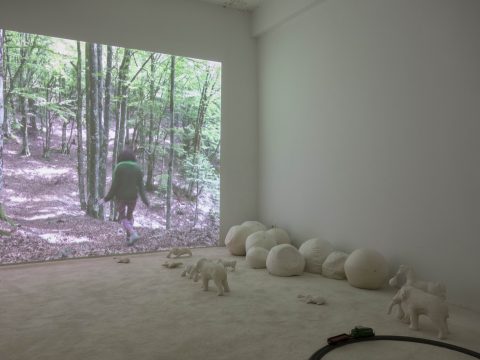What makes one’s liking come? Clara Thomine asks in her first solo show
- Clara Thomine, Vending Machine, handmade vending machine, toy capsules, 3D-printed statuettes, 2015, Courtesy of the artist and c-o-m-p-o-s-i-t-e.
- Clara Thomine, La Vraie Vie, still from video, 2014, courtesy of the artist and c-o-m-p-o-s-i-t-e.
- Clara Thomine, La Vraie Vie, still from video, 2014, courtesy of the artist and c-o-m-p-o-s-i-t-e.
- Clara Thomine, La Vraie Vie, still from video, 2014, courtesy of the artist and c-o-m-p-o-s-i-t-e.
- Clara Thomine, La Vraie Vie, still from video, 2014, courtesy of the artist and c-o-m-p-o-s-i-t-e.
- Clara Thomine, La Vraie Vie, still from video, 2014, courtesy of the artist and c-o-m-p-o-s-i-t-e.
- Clara Thomine, White Installation, plaster, carpet, toy train, 2015, courtesy of the artist and c-o-m-p-o-s-i-t-e.
- Clara Thomine, White Installation (detail), 2015, courtesy of the artist and c-o-m-p-o-s-i-t-e.
Do you like me or not? Whether you do or not depends, in countless instances, whether I meet you halfway, am willing to assume that you must like me, and show you trust and expectation. The previous faith on my part in your liking’s existence is in such cases what makes your liking come. But if I stand aloof, and refuse to budge an inch until I have objective evidence, until you shall have done something apt, ten to one your liking never comes.
From the Will to Believe by William James, 1897.
What does this extract have to do with an art exhibition one might wonder. The answer for the moment is merely factual: it was printed on a small piece of paper found in a plastic ball, a capsule we bought for €1 from a vending machine that artist Clara Thomine handmade for her current solo show, “you are lucky (like me)”, at Brussels emerging gallery c-o-m-p-o-s-i-t-e.
James’ quote is part of a lecture the philosopher gave about the role of the so-called leap of faith and our own right to adopt the belief we please, despite objective evidence to sustain it. In this particular passage, James recommends we assume that the other likes us, which might as well be the kind of leap of faith any artist has to make in his or her everyday artistic endeavour. In the case of Clara Thomine and her exhibition, this act is brought to a sharply constructive extreme.
Starting from the very object we found in the toy capsule along with James’ text (a 3D-printed bust of the artist), almost all the pieces in the show have a single individual protagonist: Clara Thomine herself, or better her body incarnating the character of the human that acts to fabricate surrounding realities.
The video Mon Amie La Rose for example shows the artist singing homonymous Francoise Hardy’s song on a stage alongside a band of motionless plastic musicians for an audience of motionless plastic fans. The lyrics are emblematic of an interest towards vivification of things that comes back throughout the exhibition like a refrain: it is the rose and artist who together sing “I blossomed/Happy and in love/The sun shined through/And by the night time I was old”.
A similar static miniature world we see in Mon Amie La Rose returns in a second video titled La Vraie Vie, where Clara Thomine breaks the fourth wall of theatrical conventions and looks straight at the spectator – this time the fleshy one in the gallery. Giving a parodical and hyper-subjective lesson on life and art, she explores what she herself experiences in an apparently unaffected and artificial world.
We say apparently here because the distinction between inanimate and animate blurs completely within the borders of the video. There is no difference in nature between the lively artist and the manufactured world around her when both are the result of a projection.
If the separation between human-made and human is put into question in the dimension of the moving image, the matter broadens when I reach the basement of the gallery and find myself immersed in an installation that combines a third video (La Forêt) with a series of sculptures in the room, whose floor is covered in soft carpet.
In contrast with the very gallery-like experience of watching video in a generic white cube, the basement is an environment in itself. The omnipresent artist is in the video, lost in a forest, calling for somebody to give a sign of presence in an irremediably human-less world. At the same time though, animals (or their plaster reproduction for that matter) are there. They wander on the floor of the room and even climb in to the projection, lined like a frozen parade.
Nothing is natural in this installation: the forest is wild and yet the artist is more present than ever, landed like an alien on her own planet; the sculptures look like the animals they depict and yet they have bizarre bubble-looking prothesis coming out of their mouths, as these creatures were ready to be given (or to take) language and use it in this otherwise very silent “real life” the artist created.
There are a number of speculations on the edges between fiction and reality, art and nature, processed and unprocessed one could draw after experiencing the complexity of “you are lucky (like me)”. What struck us the most however, is the irony and consistency with which Clara Thomine continuously exposes herself in all her artworks. By exaggerating her role of protagonist and maker in her own narration, she subtly creates a critical comment on the chronic ego-centrism of the contemporary artist, who gets transformed into a finally free-from-hubris caricature.
November 18, 2015








